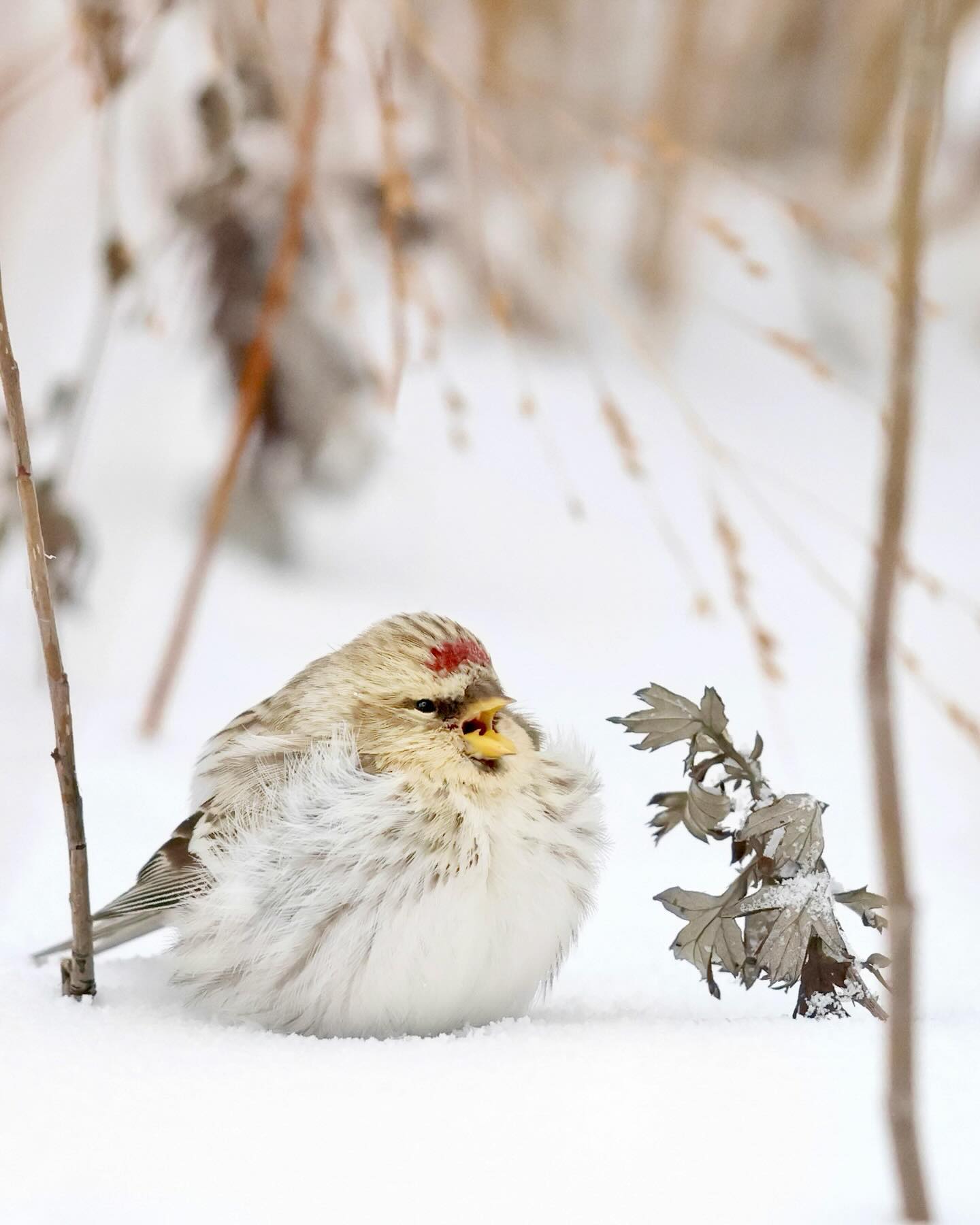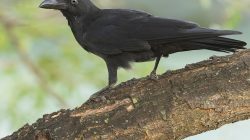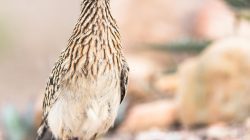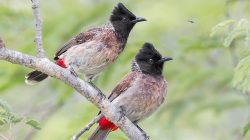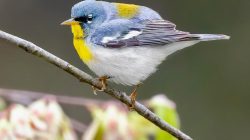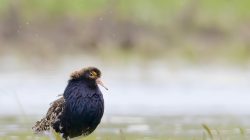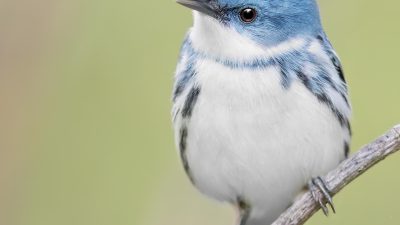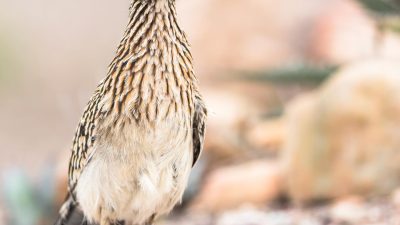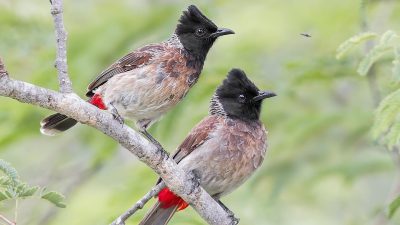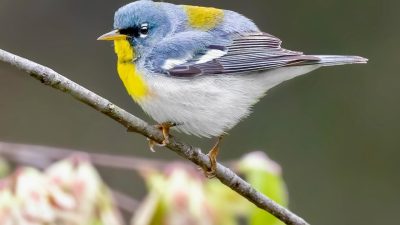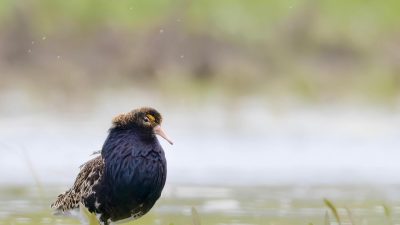Hoary Redpoll (𝘈𝘤𝘢𝘯𝘵𝘩𝘪𝘴 𝘩𝘰𝘳𝘯𝘦𝘮𝘢𝘯𝘯𝘪): A Deep Dive into a Northern Avian Wonder
Diajar.net – The Hoary Redpoll (𝘈𝘤𝘢𝘯𝘵𝘩𝘪𝘴 𝘩𝘰𝘳𝘯𝘦𝘮𝘢𝘯𝘯𝘪) is a small yet striking bird, renowned for its delicate plumage and winter adaptability. This bird’s behaviors and ecology are intriguing, making it a fascinating subject for study. Native to the cold northern reaches of the globe, the Hoary Redpoll is not only a species of beauty but also a testament to nature’s resilience in extreme environments. In this article, we will delve deeply into the various aspects of the Hoary Redpoll’s life, from its name origin to conservation efforts aimed at preserving its populations.
Origin of Animal Name
The scientific name of the Hoary Redpoll, Acanthis hornemanni, reveals much about its identity and the history of its classification. The genus name, Acanthis, comes from the Greek word for “thistle,” which is a nod to the bird’s common feeding habits on the seeds of plants such as thistles. These plants are widespread across the bird’s natural habitats, and their seeds provide a primary food source. The specific name, hornemanni, is in honor of the Danish zoologist and naturalist Jens Wilken Hornemann, who made significant contributions to the study of Northern European birds.
The common name, “Hoary Redpoll,” reflects the bird’s distinct appearance, specifically the silvery, frosted plumage that gives it a “hoary” or grayish-white appearance, and its red crown, which is a defining feature of the species.
Appearance
The Hoary Redpoll is a small passerine bird, measuring approximately 12 cm (4.7 inches) in length with a wingspan of around 24 cm (9.4 inches). Its physical appearance is one of the most defining aspects of the species. The Hoary Redpoll is characterized by its soft, pale plumage that provides it with a frosted appearance, particularly noticeable in winter. Its underparts are white or off-white, while its back and wings feature a light grayish-brown, often with subtle streaks, giving it a muted, camouflage-like appearance in snow-covered environments.
The most striking feature of the Hoary Redpoll is the small red patch on its forehead, which is characteristic of the redpoll genus. The bird also has a small, conical bill that is adapted for feeding on seeds, which is a common trait among finches. The male Hoary Redpoll typically exhibits a slightly brighter, more vivid red crown compared to females, although this difference can be subtle.
In terms of its body proportions, the Hoary Redpoll has a short tail and relatively stout wings, which make it highly agile and capable of quick flights in its arctic habitat. The bird’s plumage coloration can vary depending on environmental conditions, with some individuals appearing lighter or darker depending on their region or the season.
Distribution
The Hoary Redpoll is primarily found across the cold northern regions of the Northern Hemisphere, including parts of North America, Europe, and Asia. In North America, it is predominantly found in the northernmost parts of Canada, particularly in the territories and the northern regions of the provinces of Alberta, Saskatchewan, and Manitoba. In Europe and Asia, it is found in the Arctic regions of Iceland, Greenland, and Scandinavia, extending into Siberia.
The Hoary Redpoll’s migratory behavior is somewhat restricted compared to other species in the redpoll family. It tends to remain within its northern range year-round, although it may make short-distance migrations to slightly milder environments during the winter months. However, some Hoary Redpoll populations are known to be more migratory, heading to lower latitudes when temperatures drop drastically in the northern regions.
Geography
The geography of the Hoary Redpoll’s range is shaped by its need for specific habitats to thrive. These birds are most commonly found in open, treeless environments such as tundra, alpine meadows, and Arctic shrublands. They are well-adapted to life in areas where cold temperatures dominate, and they are often found in areas with heavy snow cover during the winter months.
The bird’s habitat selection is heavily influenced by the presence of small shrubs and herbaceous plants that provide food, as well as the availability of suitable nesting sites. Hoary Redpolls are known to inhabit both coastal and inland regions, as long as these environments meet their basic needs. During the breeding season, they tend to be found in areas with dense vegetation, where they can build their nests and find adequate food sources.
In colder climates, the Hoary Redpoll’s plumage provides it with excellent camouflage, making it an ideal resident of these northernmost regions where few other species can survive.
Habits and Lifestyle
The Hoary Redpoll is a social bird, often found in flocks that can number in the hundreds during the winter months. These flocks typically form in late autumn and remain intact until early spring when breeding season approaches. In the warmer months, Hoary Redpolls are usually found in smaller groups, as they begin to prepare for breeding.
Hoary Redpolls are generally non-aggressive and will often feed together in large numbers in areas with abundant seeds. Their foraging behavior involves hopping around plants and shrubs, using their conical bills to extract seeds from the heads of grasses, weeds, and other plants. This behavior is most evident during the colder months when food is scarce, and the birds rely on their ability to gather and consume seeds to survive.
While Hoary Redpolls are primarily seed-eaters, they are also known to consume small insects and invertebrates, particularly during the breeding season when protein-rich food is needed for the development of young birds.
During the breeding season, male Hoary Redpolls engage in courtship displays to attract females. These displays include song performances and intricate flight patterns designed to demonstrate their fitness as mates. Once a pair has formed, the female constructs a nest in a sheltered location, often near the ground, where she lays a clutch of small eggs.
Diet and Nutrition
The Hoary Redpoll has a specialized diet that revolves around the consumption of seeds, particularly those from thistles, birch trees, and willows. These seeds provide the bird with essential nutrients needed for survival in harsh environments. The birds will forage on the ground, hopping from one plant to another, using their strong, conical beaks to break open seed heads and extract the edible parts.
In addition to seeds, Hoary Redpolls occasionally supplement their diet with small insects, particularly during the breeding season when the increased demand for protein is necessary for reproduction. The small insects provide the protein needed for egg production and chick development.
During the colder months, the Hoary Redpoll’s diet is heavily reliant on seeds, which they can store and access throughout the winter. However, they must be highly adaptable in their foraging behavior, as food availability can fluctuate with the seasons, and competition with other species can intensify during the winter months.
Population and Number of Populations
The Hoary Redpoll is considered to have a relatively stable population, though its numbers are not as high as some other finch species. The bird’s populations are primarily concentrated in the northernmost regions, but these populations can be difficult to quantify due to the bird’s migratory behavior and its preference for remote and often inhospitable habitats.
In terms of global population estimates, the Hoary Redpoll is not currently listed as being at significant risk. However, its population numbers can fluctuate based on food availability, climate conditions, and habitat loss. In some areas, the population density of Hoary Redpolls can be high, particularly during the winter months when the birds gather in large flocks to survive the harsh conditions.
Estimates of the total population of Hoary Redpolls are difficult to determine accurately, but it is believed that the bird’s numbers are in the hundreds of thousands. This population is spread across its extensive range, which includes areas of North America, Europe, and Asia.
Conservation
Although the Hoary Redpoll is not currently considered a species at risk, conservation efforts are important to ensure that its populations remain stable in the face of environmental challenges. The bird’s primary threats include habitat loss due to climate change, as well as competition for food resources with other bird species.
As temperatures rise and habitats in the Arctic and sub-Arctic regions are altered, Hoary Redpolls may find it more difficult to access the food sources they rely on. Additionally, the loss of suitable nesting sites due to changes in vegetation cover could affect the bird’s ability to breed successfully.
Conservation efforts focused on protecting the bird’s natural habitat and ensuring that its food sources remain abundant are essential for preserving the Hoary Redpoll’s populations. Monitoring of population trends and habitat conditions is also crucial in identifying potential threats to the species in the future.
Efforts to mitigate the impacts of climate change, such as reducing carbon emissions and promoting the conservation of cold-climate ecosystems, will play a key role in preserving the Hoary Redpoll’s habitat. Additionally, more research into the bird’s specific needs and ecological behavior will help guide conservation strategies to maintain healthy populations of this remarkable species.
Conclusion
The Hoary Redpoll (𝘈𝘤𝘢𝘯𝘵𝘩𝘪𝘴 𝘩𝘰𝘳𝘯𝘦𝘮𝘢𝘯𝘯𝘪) is a fascinating bird that thrives in some of the harshest climates on Earth. With its distinctive appearance, adaptable diet, and social behaviors, it is a testament to the resilience of life in the extreme northern regions. Although its population is currently stable, continued conservation efforts are needed to protect this species from the growing threats of climate change and habitat destruction. By understanding the Hoary Redpoll’s habits, diet, and geography, we can continue to support its preservation and ensure that this small but mighty bird remains a part of our natural world for generations to come.
